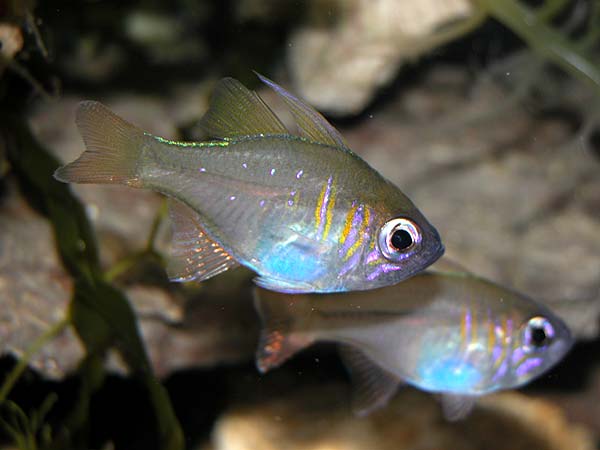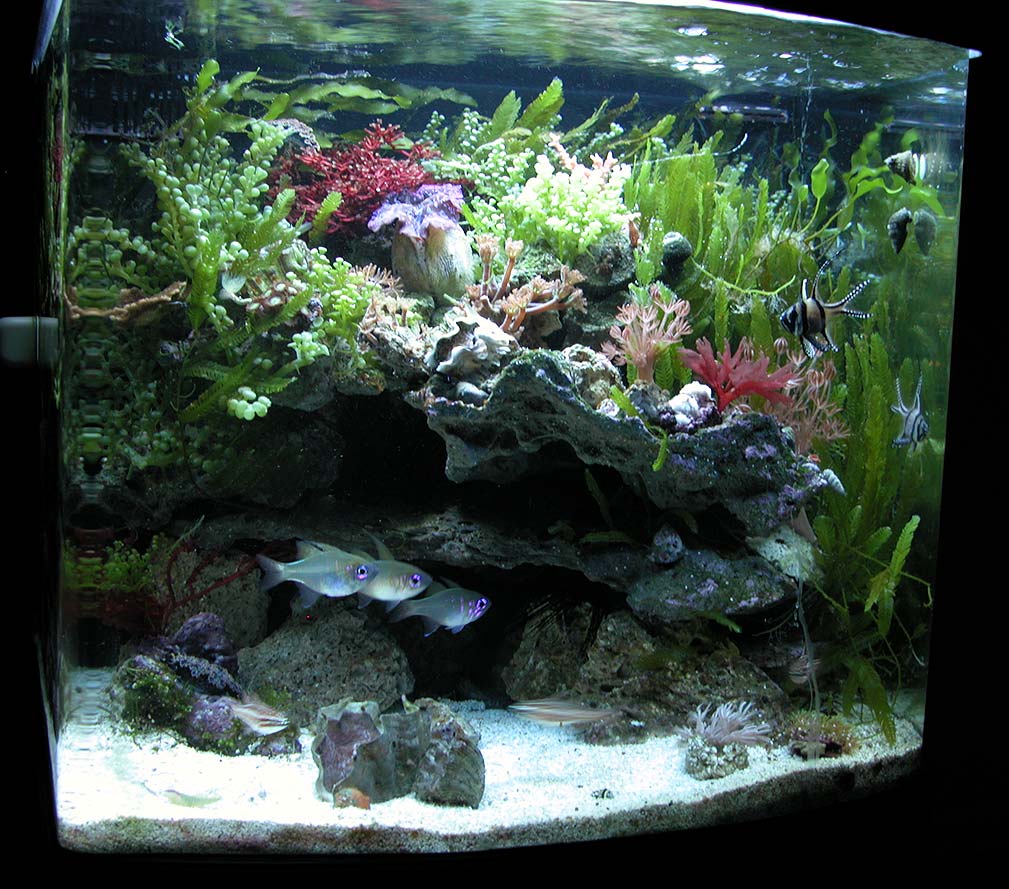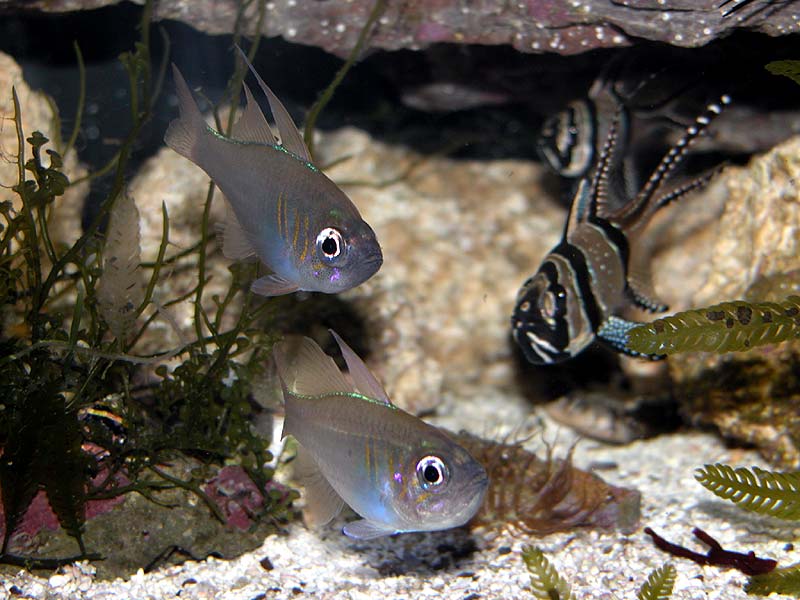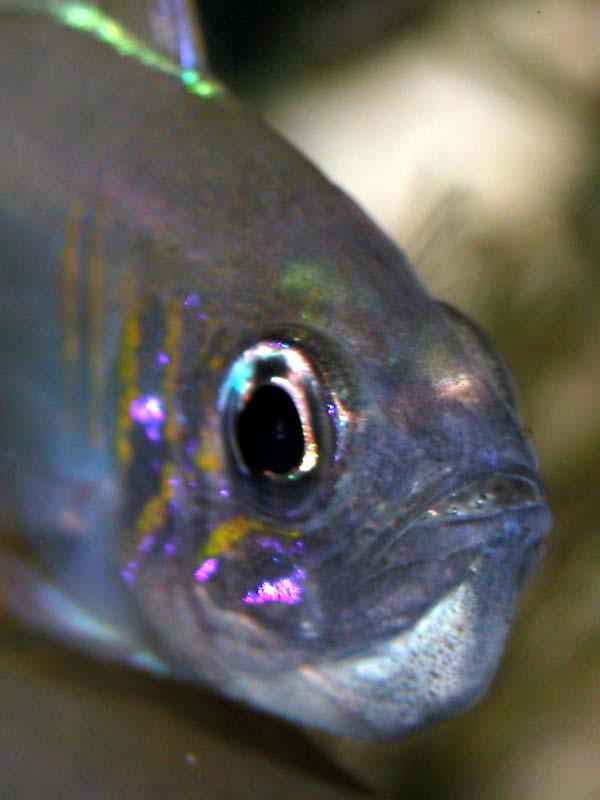OK - after looking at the muddled mess of all my threads, it's time to reorganize. Since I'm working with 3 cardinalfish species it makes more sense to dedicate a thread to each one. This first post gathers up all the details I have from all the prior threads as well as my notes (stored in the spreadsheet I use to log everything I do on the tank).
Apogon leptacanthus
Common Names: Threadfin Cardinalfish, Blue Eyed Cardinalfish, White Cardinalfish, Ghost Cardinalfish, Blue Streak Cardinalfish, Longspine Cardinalfish, Glass Cardinalfish etc...
 Quick synopsis of tank/care/diet etc..
Quick synopsis of tank/care/diet etc..

Tank - 24 galllon Nano Cube, stock tank and lighting, only changes is additional aeration (airstone in 2nd chamber) and addition of Purigen.
Co-Inhabitants - 1m/1f Pterapogon kaudernii, 2m/1f Apogon margaritophorus, 1m/1f Synchiropus splendidus, 1m/1f Greenbanded Gobies (I've seen too many different scientific names to know which one to use anymore!), 2 Nemateleotris magnifica (suspected pair of Firefish). This tank is set up as a reef, dominated by Caulerpa sp. and other macro algaes, but also a variety of snails, hermits, a longspine urchin, coral frags etc...
Diet - Frozen Foods include: SF Bay Enriched Brine, SF Bay Spirulina Enriched Brine, Hikari Enriched Brine, Hikari Mysis, Cyclopeze, Formula 1. Occasional Live Foods Include: Live Brine Shrimp, adult and nauplii. Dried foods: they'll take flakes but they're not happy about it (I usually use OSI Spirulina or Tetra Marine Flakes). I periodically soak frozen foods with SELCON. Overall, I'd say the Apogon leptacanthus are some of the most aggressive feeders in the tank...they're little fish with BIG mouths!
Tank Care & Conditions - pH typically 8.2. Temps in upper 70's. Specific Gravity around 1.022 usually. Water changes are 3 gallons, weekly or as needed. All organic levels are very low to nonexistent (i.e. < 1 ppm Nitrate, 0 on the rest). Calcium levels while probably not relevant hover between 350 and 400.
TIMELINE / Synopsis of breeding activity & behavior
11-25-05 - Added 2 Apogon leptacanthus from a group of recently imported wild caught fish (selected smallest and largest, smallest with short fins, largest with very elongated fins. Suspected Male/Female pair...)
11-26-05 - Went back to the LFS and picked up 2 more Apogon leptacanthus, again selecting disparate sizes and fin lengths in the hopes of obtaining a pair.
11-29-05 - the "longest" finned Apogon leptacanthus has yet to take any food. The others are currently only feeding on live brine shrimp.
12-3-05 - the A. leptacanthus that hasn't been feeding is now on his last legs - "he" was humanely euthanized. At this point the others are starting to accept frozen mysis and brine shrimp.
12-15-05 - I first noted "hints" of courtship or pairbonding activity between 2 of the Apogon leptacanthus.
12-18-05 - my notes indicate that it looks likely that we have 2 males & 1 female. 2 fish (one large, one small) have paired up over the last couple days, leaving an "odd man out", another larger fish (suspected male at this point).
12-20-05 - 2nd recording of "intensified" courtship between 2 of the Apogon leptacanthus. A day later video of the activity is posted.
Quote:
Then there's the Apogon leptacanthus - this is the 2nd time I've caught what appears to be courtship activity. The first time was just a couple days ago, and it really kicked into "high" gear on the same night the Lattice Cardinals spawned....nothing came from the Threadfins though.
From what I can gather, my A. leptacanthus group has turned out to be 2m/1f as the smallest, shortest finned fish spends most of it's time with the largest, longest finned fish and is displaying to him, but I've also caught her displaying to the "middle" fish...aha - another male...at least that's how it seems. Like their coloration, it appears their courtship behavior is a bit more subdued than the other cardinalfish in the tank. The female will come out in front of the male, display her flank and puff out her throat. Then she'll circle around and come back to the males side. Once in a while she'll nudge him (just like the Lattice Cardinals), occasionally he'll give her a nip around her "butt" as well. Of special note, the females fins have become tipped in blue this evening, and in general the amount and intesity of the blue coloration has risen in ALL THREE of the A. leptacanthus.
|
12-30-05 - The Apogon leptacanthus were courting in their "subdued" way but did not spawn.
2-3-06 - FIRST SPAWNING of Apogon leptacanthus somewhere between 9:30 and 10:45 PM. Turns out I had the sexes in the "pair" reversed. The larger, more colorful and longer finned fish (which behaves as the dominant fish in the group of 3) is a FEMALE. The smallest fish, with shorter fins and less intense coloration, is the male who is now holding! I was able to post additional observations and videos:
Quote:
These next two vids are of courtship. Again, up until this first spawn I believed I had 2 males and 1 female. Well, what I THOUGHT was the male courting I should have known better...the larger fish with longer fins shown in this video is the FEMALE. She is courting the smallest one in our group of 3, who turned out to be a MALE?! As far as sexual dimorphism goes, this is kinda backwards from most, but it could simply be based on limited mate availability in this captive situation.
There's a couple really important behaviors to watch for. The first is the side-by-side twitching which seems to be common amoung all three of the cardinalfish species we've spawned. In this particular case, the female "flicks" her fins much like a Firefish normally does when swimming. There is no discernable "vibrations" (like what you see in Pterapogon kauderii).
The other behavior that is NEW is the "soar" for lack of a better term. I've seen throat bulging, side-by-side twitching, and nudging go on between this pair of fish on numerous occasions. However, I have not seen the "soar". In both videos it occurs towards the end, the female making broad circles out in front of the male. My earlier description I inverted the "fins" - the female clamps all fins on her ventral side while leaving the dorsal fins semi erect. It's wierd, but it seems like she's trying to show off her big fat belly to the male.
Also, note that in these vids, the belly is distended (a common sign that spawning is IMMINENT in the next couple hours). It appears that her ovipositor has dropped. Unfortunately, I don't have an exact spawning time on these guys...it was an afternoon event and well, we went out for dinner! Next time maybe.
Without further delay, 2 vids of pre-spawn courtship behavior in Apogon leptacanthus!
http://www.cichlidrecipe.com/nanoree...fin_soar1.html
http://www.cichlidrecipe.com/nanoree...fin_soar2.html
And what the heck, the proof that this wasn't just pair-bonding or aggression, here's the male with the female (as well as a brief start with the "spare" fish). Look at the mouthful of eggs!
http://www.cichlidrecipe.com/nanoree...postspawn.html
Next up, one of the best pics I've gotten in the former "clam" tank - the pair of Bangers and the pair of Threadfins, both with mouthbrooding males.

|
2-11-05 - earlier in the day, I shot some pics of the male mouthbrooding.
Quote:
Male Apogon leptacanthus, on the evening of the 8th day post spawning.

|
Just before midnight (about 30 minutes after light out, 11:45 PM) the male Apogon leptacanthus releases live larvae. That's 8 days from spawning to release. Many of the larvae ended up dead. That night I shot some larval images.
2-12-06 - Looks like we have about 10 viable larvae:
Quote:
We're now 12 hours in with 9-10 viable larvae from this first spawn of Apogon leptacanthus. They are in a large specimen cup, hanging in the parents tank, roughly 1/2 gallon in volume. Aeration is going at a few bubbles per second.
This morning I cleaned out all the dead larvae (around 30-40) - again, it looks as though they were damaged by being transfered with the brine shrimp net.
I introduced 25 ML from a Nannochloris culture and 10 ML from a Tetraselmis culture. My first shot at Isocrysis didn't work, so that culture just got restarted yesterday. Nannochloropsus only got started yesterday as well, so we're not ready for that either.
I also added some L-Strain rotifers...not tons, but a fair amount. So far, the rotifers look just a little bit "too large" for these little guys, and NO feeding activity has been observed. Granted, when the hatched out MOST larvae had a little bit of a yolk salk still being absorbed, so they may not be ready for feeding quite yet.
Wish us TONS of luck...I'd love to raise up a half dozen of these...that'd be plenty success for me!
|
2-13-06 - No additional larval deaths. Things don't look "great", but at least they're still alive:
Quote:
Just about 48 hours in an I can't say we've had any additional deaths in the larvae! I've added more Tetraselmis & Nannochloris along with a very limited dosing of Nannochloropsus (that culture is still in the "early" phases but I figured it couldn't hurt).
I'd say there's really "2 sets" of larvae. One small group (3-4) hang out at the opposite end of the specimen cup from the air-feed. For the most part they rest on the bottom, occasionally swimming around. They appear to be feeding, as their guts are "rounded" behind the eyes. I have high hopes for these courageous little fish.
The other 6-7 also spend most of their time on the bottom. These guys however have "attitude" control issues. When not on the bottom, the float around, listless at ANY orientation, occasionally righting themselves. If they get caught up in the current from the air-feed, they seem to get very dissoriented. Some of these larvae are "larger" than the first set but appear skinny.
ALL of the larvae spend the majority of their time "wallowing" in the bottom gunk. They are usually upright on the bottom, although sometimes one can be seen lying on it's side. All larvae, to varying degrees of frequency, make lunging/smashing juts at the bottom - it looks like feeding in a larger grazing fish....
I'm hesitant to sample any of the larvae at this point for fear of accidently killing them (but may give one of the "free floaters a look"...9-10 isn't much to work with, but we're about ready to tie the "goby larvae" record for survival in the same setup...an no deaths beyond those initial ones at collection (when we experienced heavy mortality).
FWIW, I did take out one of the free floaters and looked at him under 10X...the gut (area behind and underneath the "air bubble" swim bladder) has a bronze-green tint to it.....got a nice big mouth too, but still looks too small for the rotifers that were in the sample. So maybe these guys are feeding on the various Phyto's I've been adding in?
|
2-14-06 - Still no deaths and things look better:
Quote:
We're now well into the third day! Lights came on this morning, the little larvae "woke up" and started smashing the bottom (feeding?). Added in more Tetraslemis and Nannochloris, + the Nannochloropsus is now at 2 mil/ML so I figured "what the heck" and added more of that as well. If only the Isocrysis would kick in...then they'd have a fully diverse algae soup to grow in. Added some more rotifers as well - rotifers from one of the cultures looked "smaller" under 10X...if so, they'd be IDEAL food for these guys.
Less "free floaters" today as well...more and more are starting to get in the grove and forage in the gunk on the bottom of the specimen cup. These developments make it all the more likely that the goby babies aren't getting FOOD whereas the cardinalfish larvae, being just a touch bigger, can handle it. We should have a hatch tonight or tomorrow on the gobies...anyone in Chicago want to try raising 'em?
|
Which brings us to the present. I'll post all future developments with our Apogon leptacanthus in this thread!
MP